If your web-browser opens automatically to scam web sites offering “get”, “win” or “receive” an iPhone 8, then your machine can be infected by an adware (also known as ‘ad-supported’ software), which was set on your system without your consent. The adware may change the settings of web-browsers like Firefox, Chrome, Internet Explorer and Microsoft Edge in order to show lots of undesired pop-ups and ads. So, every time when you open the internet browser or browse the Web, it’ll always be forced to open various unwanted pages including misleading sites such as the IPhone 8 scam. On current date, the adware continues to increase the number of PC systems which have been infected. Below we explain how to remove ad supported software and thereby get rid of iPhone 8 scam pop-ups from your internet browser.

The full text of the misleading message is:
We would like to thank you for your loyalty to Facebook, therefore, we offer you a chance to receive an iPhone 8. Find an iPhone 8 All you have to do is choose the correct gift box.
It is likely that you might be bothered with the adware that redirects your internet browser to undesired iPhone 8 scam web-site. You should not disregard this unwanted software. The ad supported software might not only display annoying advertisements, but redirect your browser to shady web sites. What is more, the adware can analyze your surfing, and gain access to your user data and, afterwards, can sell it to third parties. Thus, there are more than enough reasons to delete iPhone 8 scam popups from your PC system.
The ‘ad supported’ software usually affects only the FF, Chrome, IE and Edge by modifying the web-browser’s settings or installing a harmful extensions. Moreover, possible situations, when any other web-browsers will be affected too. The adware will perform a scan of the computer for browser shortcut files and change them without your permission. When it infects the web-browser shortcuts, it’ll add the argument like ‘http://site.address’ into Target property. So, each time you open the internet browser, you will see an unwanted iPhone 8 scam web-page.
Thus, it is clear that the presence of adware on your computer is not desirable, and you need to clean up your personal computer as soon as possible. Follow the step by step tutorial below in order to remove iPhone 8 scam popups.
How to remove iPhone 8 scam pop-ups
Fortunately, we have an effective solution which will assist you manually or/and automatically get rid of iPhone 8 scam from your browser and bring your web browser settings, including home page, new tab page and search engine by default, back to normal. Below you will find a removal steps with all the steps you may need to successfully remove adware and its components. Certain of the steps below will require you to exit this web site. So, please read the tutorial carefully, after that bookmark or print it for later reference.
To remove iPhone 8 scam, execute the following steps:
- Remove iPhone 8 scam pop ups without any utilities
- Uninstall suspicious applications using Windows Control Panel
- Disinfect the web-browser’s shortcuts to remove iPhone 8 scam redirect
- Remove iPhone 8 scam redirect from Chrome
- Delete iPhone 8 scam from Firefox by resetting web-browser settings
- Get rid of iPhone 8 scam pop ups from IE
- Remove unwanted Scheduled Tasks
- Scan your personal computer and remove iPhone 8 scam pop-ups with free tools
- Use AdBlocker to block iPhone 8 scam and stay safe online
- How did you get infected with iPhone 8 scam pop-up
- Finish words
Remove iPhone 8 scam pop ups without any utilities
The following instructions is a step-by-step guide, which will help you manually remove iPhone 8 scam redirect from the Chrome, Internet Explorer, Firefox and Microsoft Edge.
Uninstall suspicious applications using Windows Control Panel
The process of ad-supported software removal is generally the same across all versions of MS Windows OS from 10 to XP. To start with, it is necessary to check the list of installed applications on your computer and remove all unused, unknown and dubious programs.
Press Windows button ![]() , then click Search
, then click Search ![]() . Type “Control panel”and press Enter. If you using Windows XP or Windows 7, then press “Start” and select “Control Panel”. It will show the Windows Control Panel as shown on the screen below.
. Type “Control panel”and press Enter. If you using Windows XP or Windows 7, then press “Start” and select “Control Panel”. It will show the Windows Control Panel as shown on the screen below.

Further, press “Uninstall a program” ![]()
It will show a list of all software installed on your personal computer. Scroll through the all list, and delete any questionable and unknown programs.
Disinfect the web-browser’s shortcuts to remove iPhone 8 scam redirect
When the adware is started, it can also change the web-browser’s shortcuts, adding an argument such as “http://site.address” into the Target field. Due to this, every time you launch the web browser, it will open an undesired site.
Right click on the shortcut file of infected browser as shown on the image below.
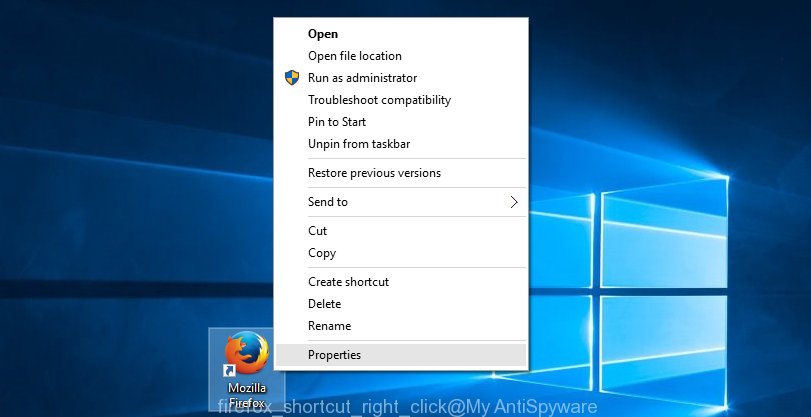
Select the “Properties” option and it’ll display the shortcut file’s properties. Next, click the “Shortcut” tab and then delete the “http://site.address” string from Target field as on the image below.
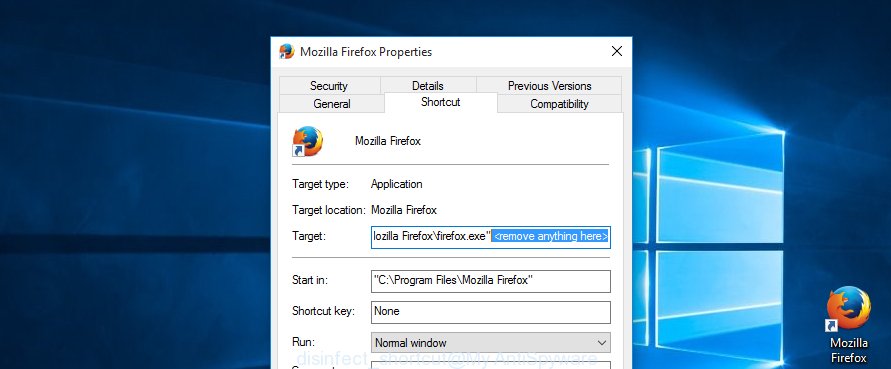
Then press OK to save changes. Repeat the step for all web browsers that are redirected to the iPhone 8 scam annoying web site.
Remove iPhone 8 scam redirect from Chrome
Use the Reset web browser tool of the Google Chrome to reset all its settings like new tab page, start page and search engine by default to original defaults. This is a very useful utility to use, in the case of internet browser redirects to undesired ad web pages such as iPhone 8 scam.
First start the Chrome. Next, click the button in the form of three horizontal dots (![]() ).
).
It will display the Chrome menu. Select More Tools, then press Extensions. Carefully browse through the list of installed extensions. If the list has the add-on signed with “Installed by enterprise policy” or “Installed by your administrator”, then complete the following guidance: Remove Chrome extensions installed by enterprise policy.
Open the Google Chrome menu once again. Further, click the option named “Settings”.

The web-browser will open the settings screen. Another way to show the Chrome’s settings – type chrome://settings in the web-browser adress bar and press Enter
Scroll down to the bottom of the page and press the “Advanced” link. Now scroll down until the “Reset” section is visible, as displayed in the figure below and click the “Reset settings to their original defaults” button.

The Google Chrome will open the confirmation prompt as on the image below.

You need to confirm your action, press the “Reset” button. The internet browser will start the procedure of cleaning. Once it’s done, the web-browser’s settings including home page, new tab page and search provider by default back to the values which have been when the Chrome was first installed on your PC.
Delete iPhone 8 scam from Firefox by resetting web-browser settings
If the Mozilla Firefox settings like newtab page, home page and search provider by default have been modified by the ad-supported software, then resetting it to the default state can help.
Click the Menu button (looks like three horizontal lines), and click the blue Help icon located at the bottom of the drop down menu as displayed in the figure below.

A small menu will appear, click the “Troubleshooting Information”. On this page, click “Refresh Firefox” button as displayed in the following example.

Follow the onscreen procedure to return your Mozilla Firefox internet browser settings to its original state.
Get rid of iPhone 8 scam pop ups from IE
By resetting IE internet browser you return your web browser settings to its default state. This is first when troubleshooting problems that might have been caused by ad supported software that causes multiple undesired popups.
First, launch the Microsoft Internet Explorer. Next, click the button in the form of gear (![]() ). It will open the Tools drop-down menu, click the “Internet Options” as displayed in the following example.
). It will open the Tools drop-down menu, click the “Internet Options” as displayed in the following example.

In the “Internet Options” window click on the Advanced tab, then press the Reset button. The Internet Explorer will display the “Reset Internet Explorer settings” window as on the image below. Select the “Delete personal settings” check box, then press “Reset” button.

You will now need to reboot your machine for the changes to take effect.
Remove unwanted Scheduled Tasks
If the undesired iPhone 8 scam web-site opens automatically on Windows startup or at equal time intervals, then you need to check the Task Scheduler Library and remove all the tasks which have been created by malicious applications.
Press Windows and R keys on your keyboard simultaneously. It will open a prompt that titled with Run. In the text field, type “taskschd.msc” (without the quotes) and click OK. Task Scheduler window opens. In the left-hand side, click “Task Scheduler Library”, as displayed on the image below.

Task scheduler, list of tasks
In the middle part you will see a list of installed tasks. Select the first task, its properties will be display just below automatically. Next, press the Actions tab. Necessary to look at the text which is written under Details. Found something like “explorer.exe http://site.address” or “chrome.exe http://site.address” or “firefox.exe http://site.address”, then you need remove this task. If you are not sure that executes the task, then google it. If it’s a component of the ‘ad-supported’ program, then this task also should be removed.
Further click on it with the right mouse button and select Delete as displayed below.

Task scheduler, delete a task
Repeat this step, if you have found a few tasks that have been created by malicious applications. Once is complete, close the Task Scheduler window.
Scan your personal computer and remove iPhone 8 scam pop-ups with free tools
Many antivirus companies have created software that allow detect ‘ad supported’ software and thereby remove iPhone 8 scam from the Firefox, Chrome, IE and MS Edge internet browsers. Below is a a few of the free programs you may want to use. Your PC may have lots of PUPs, adware and hijackers installed at the same time, so we suggest, if any unwanted or malicious application returns after rebooting the PC, then start your machine into Safe Mode and use the anti-malware tool again.
How to remove iPhone 8 scam pop-up with Zemana Anti-malware
We recommend using the Zemana Anti-malware. You can download and install Zemana Anti-malware to search for and remove iPhone 8 scam redirect from the Google Chrome, Firefox, Edge and Internet Explorer browsers. When installed and updated, the malicious software remover will automatically scan and detect all threats exist on your machine.
Please go to the following link to download the latest version of Zemana Free for Windows. Save it on your Desktop.
164725 downloads
Author: Zemana Ltd
Category: Security tools
Update: July 16, 2019
Once the downloading process is complete, close all windows on your PC system. Further, launch the set up file named Zemana.AntiMalware.Setup. If the “User Account Control” dialog box pops up as shown in the figure below, click the “Yes” button.

It will open the “Setup wizard” which will allow you install Zemana AntiMalware on the personal computer. Follow the prompts and do not make any changes to default settings.

Once installation is finished successfully, Zemana Free will automatically start and you can see its main window as displayed on the screen below.

Next, click the “Scan” button . Zemana Anti-Malware (ZAM) utility will begin scanning the whole PC to find out ad supported software responsible for redirecting your browser to iPhone 8 scam web site. A scan may take anywhere from 10 to 30 minutes, depending on the number of files on your computer and the speed of your PC system. During the scan Zemana will detect threats exist on your PC.

When Zemana Anti-Malware (ZAM) has finished scanning your PC, Zemana Anti-Malware will open a list of found items. In order to get rid of all threats, simply click “Next” button.

The Zemana Anti Malware (ZAM) will remove adware responsible for redirecting your web-browser to iPhone 8 scam web-site. After finished, you can be prompted to restart your machine.
Automatically get rid of iPhone 8 scam pop up with Malwarebytes
We advise using the Malwarebytes Free which are completely clean your PC of the adware. The free tool is an advanced malware removal application created by (c) Malwarebytes lab. This program uses the world’s most popular antimalware technology. It’s able to help you get rid of intrusive iPhone 8 scam redirect from your browsers, PUPs, malware, browser hijacker infections, toolbars, ransomware and other security threats from your computer for free.
Download MalwareBytes Anti Malware (MBAM) by clicking on the following link. Save it directly to your Windows Desktop.
326999 downloads
Author: Malwarebytes
Category: Security tools
Update: April 15, 2020
Once the download is finished, close all programs and windows on your personal computer. Open a directory in which you saved it. Double-click on the icon that’s called mb3-setup like below.
![]()
When the install begins, you will see the “Setup wizard” which will help you install Malwarebytes on your machine.
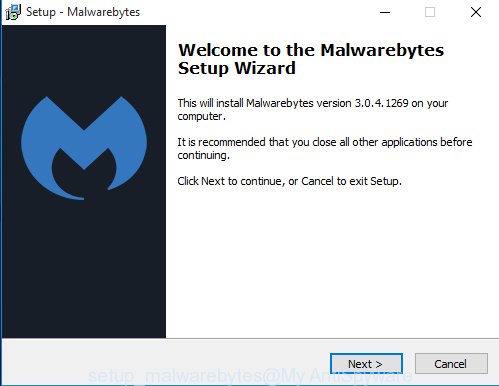
Once installation is complete, you’ll see window like below.
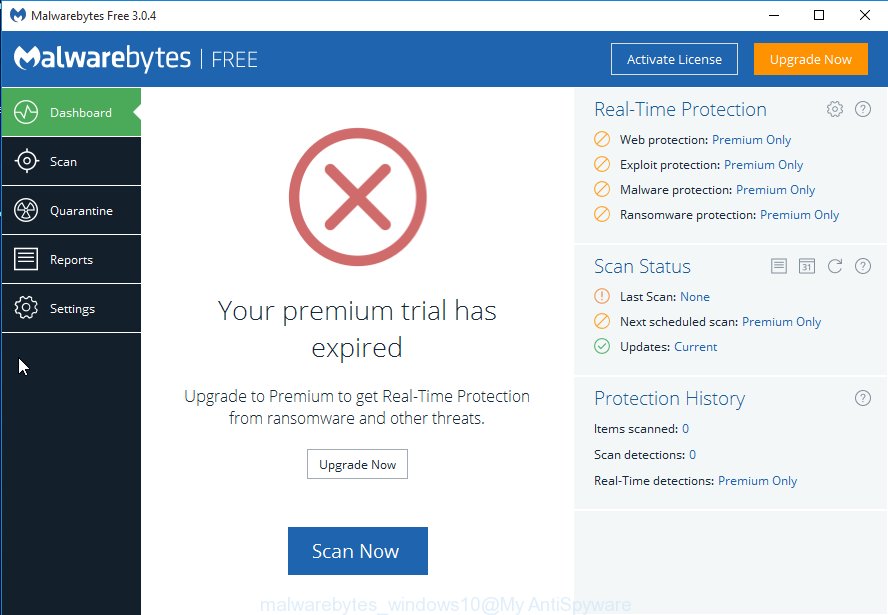
Now click the “Scan Now” button for scanning your computer for the adware which cause annoying iPhone 8 scam pop-up to appear. This process may take quite a while, so please be patient. During the scan MalwareBytes Anti Malware (MBAM) will look for threats exist on your computer.
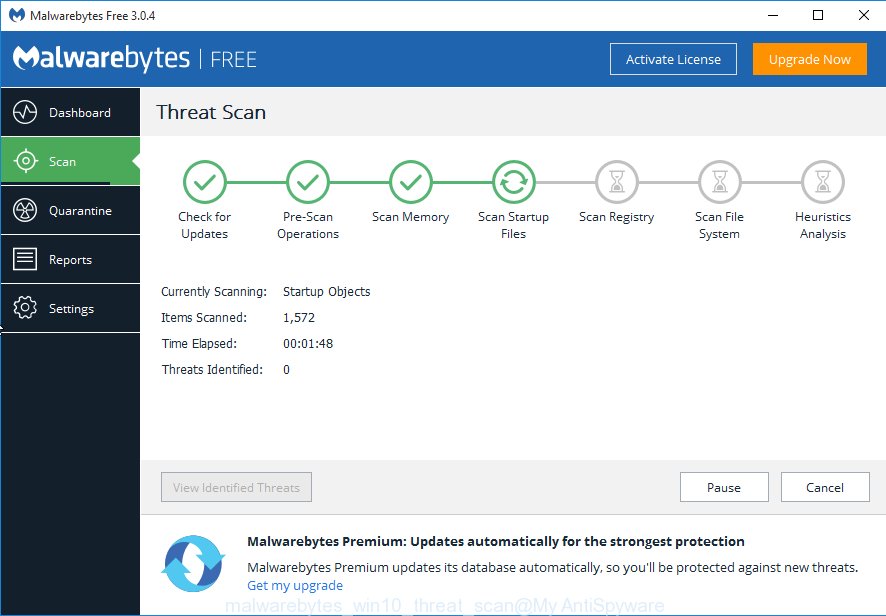
After that process is finished, MalwareBytes will show a screen that contains a list of malicious software that has been found. In order to get rid of all items, simply press “Quarantine Selected” button.

The Malwarebytes will now remove ‘ad supported’ software which cause undesired iPhone 8 scam popups to appear. When the task is finished, you may be prompted to restart your personal computer.
The following video explains instructions on how to get rid of browser hijacker, ‘ad supported’ software and other malicious software with MalwareBytes.
If the problem with iPhone 8 scam popups is still remained
AdwCleaner is a portable utility that searches for and uninstalls undesired programs such as hijacker infections, adware, toolbars, other browser addons and other malware. It scans your computer for adware responsible for iPhone 8 scam redirect and prepares a list of threats marked for removal. AdwCleaner will only erase those unwanted software that you wish to be removed.
Visit the following page to download AdwCleaner. Save it to your Desktop.
225510 downloads
Version: 8.4.1
Author: Xplode, MalwareBytes
Category: Security tools
Update: October 5, 2024
After downloading is finished, open the file location and double-click the AdwCleaner icon. It will launch the AdwCleaner tool and you will see a screen as shown in the figure below. If the User Account Control prompt will ask you want to open the program, press Yes button to continue.
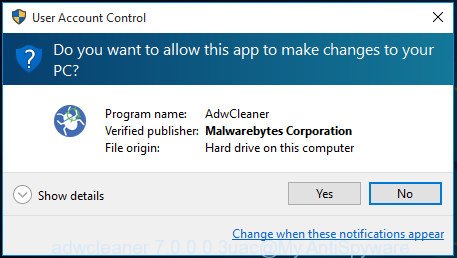
Next, click “Scan” to begin scanning your machine for the ‘ad supported’ software responsible for redirecting your web browser to iPhone 8 scam web-site. Depending on your system, the scan may take anywhere from a few minutes to close to an hour. While the utility is scanning, you may see number of objects and files has already scanned.
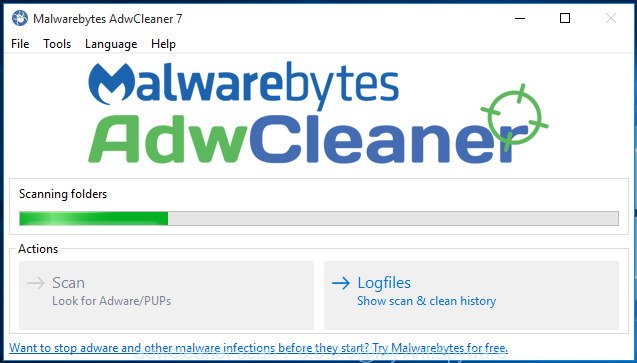
After the checking is finished, AdwCleaner will open a scan report as displayed on the image below.
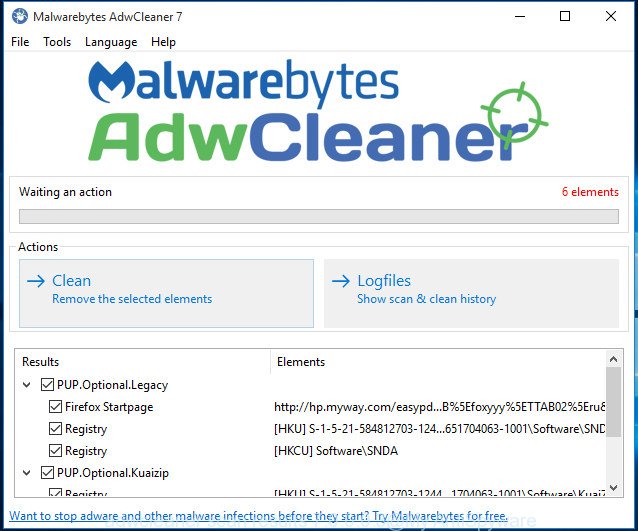
Review the scan results and then press “Clean” button. It will display a prompt. Click “OK” button. The AdwCleaner will start to get rid of ad-supported software which redirects your web-browser to intrusive iPhone 8 scam page. Once disinfection is finished, the utility may ask you to restart your personal computer. After restart, the AdwCleaner will open the log file.
All the above steps are shown in detail in the following video instructions.
Use AdBlocker to block iPhone 8 scam and stay safe online
It is also critical to protect your web-browsers from malicious web pages and advertisements by using an ad blocking application such as AdGuard. Security experts says that it will greatly reduce the risk of malware, and potentially save lots of money. Additionally, the AdGuard can also protect your privacy by blocking almost all trackers.
Download AdGuard program by clicking on the following link. Save it to your Desktop.
26824 downloads
Version: 6.4
Author: © Adguard
Category: Security tools
Update: November 15, 2018
Once the downloading process is finished, launch the downloaded file. You will see the “Setup Wizard” screen like below.

Follow the prompts. When the setup is finished, you will see a window as on the image below.

You can click “Skip” to close the installation program and use the default settings, or click “Get Started” button to see an quick tutorial which will allow you get to know AdGuard better.
In most cases, the default settings are enough and you don’t need to change anything. Each time, when you run your computer, AdGuard will run automatically and block popup, web-pages such iPhone 8 scam, as well as other harmful or misleading pages. For an overview of all the features of the application, or to change its settings you can simply double-click on the AdGuard icon, that is located on your desktop.
How did you get infected with iPhone 8 scam pop-up
These days certain free programs creators bundle optional apps which could be PUPs such as this ad supported software, with a view to making some money. These are not free programs as install an unwanted software on to your Microsoft Windows computer. So whenever you install a new free program that downloaded from the Net, be very careful during installation. Carefully read the EULA (a text with I ACCEPT/I DECLINE button), select custom or manual installation method, disable all third-party applications.
Finish words
Now your computer should be clean of the adware responsible for redirecting your internet browser to iPhone 8 scam web-page. Remove AdwCleaner. We suggest that you keep AdGuard (to help you block unwanted popups and annoying malicious web sites) and Zemana Anti-Malware (ZAM) (to periodically scan your personal computer for new adwares and other malicious software). Probably you are running an older version of Java or Adobe Flash Player. This can be a security risk, so download and install the latest version right now.
If you are still having problems while trying to get rid of iPhone 8 scam pop-ups from the Chrome, Firefox, IE and Microsoft Edge, then ask for help in our Spyware/Malware removal forum.




















